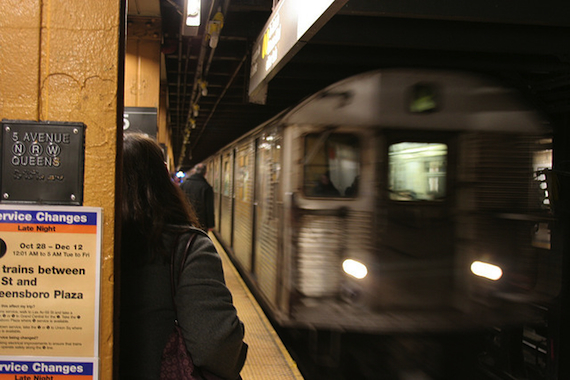
At 8 a.m. on a recent Monday, my first morning back in New York City after a year and a half away, I looked up from my newspaper – a Wall Street Journal, given away for free at my Financial District hotel – and saw that I was the only rider on the R train leaving South Ferry at the base of Manhattan reading print. Every other rider on the subway car was staring at a screen.
In 2004, when I first moved to Brooklyn, the commute on the New York subways was a world of paper. In the evenings most people read books or magazines, and in the morning it was newspapers. Riders from the outermost neighborhoods read the Post and the Daily News while those closer in read the Times and the Journal, fussily folding the broadsheet pages into quarters for easy reading on crowded trains. Here and there, a few younger kids might be sporting earbuds connected to then-newfangled iPods, but even most of them had at least a freebie AM New York parked in front of their faces.
To friends living elsewhere I described the New York subway system as a rolling public library. It was like one of those big, messy city library reading rooms where homeless men passing the time reading the day’s news sat next to uptight city-college profs correcting student papers minutes before class. New York is the only place I have ever enjoyed my commute. Each morning, as soon as the doors slid shut behind me I opened up my book and entered a different world for the twenty minutes it took me to get from my Brooklyn neighborhood to Midtown Manhattan.
A decade later, like real libraries across the country, New York’s rolling library is going digital. That first morning on the R train turned out to be an extreme example, but on every train I rode during my week back in New York, screens outnumbered printed pages, sometimes by a factor of two to one. When I’ve peeked, some of those screens have been displaying news stories and magazine pages and even a few books, but far more often my fellow subway riders were watching TV shows or playing Candy Crush on their phones.
None of this should come as a surprise, of course. The demise of the printed newspaper is by now very old news and it’s hard to imagine a venue where the shift from printed pages to screens makes more sense than on a crowded subway. Still, the speed and starkness of the change is a shock. A decade ago, none of the devices my R train companions were so avidly viewing even existed. Back then, if you didn’t want to read on your morning subway commute, you stared off into space.
When we talk about books, we tend to think in terms of great works of art and forget that for most people books, like newspapers and magazines, are merely a handy thing to have around for that idle moment when there isn’t something else better to do. Now, more and more often, those idle moments – on subway cars, on airplanes, in dentist’s offices – are being filled by games and movies and social media. By screens.
This doesn’t necessarily mean the end is nigh for literature as we know it. The golden age of American theater came in the 1940s and 1950s, a generation after radio and talking pictures seemingly outmoded live theater. Arguably, some of the greatest movies American directors have ever produced debuted in the 1970s, a generation after television seemingly outmoded movies. Still, a vibrant art form has to serve a utilitarian function in ordinary people’s lives or it gradually becomes relegated to the museum and the specialist viewer, as has happened to visual art and, more recently, to live theater. And if the printed page can’t survive on a New York City subway car, that once-great rolling library, where else can it survive?
Image via Erwin Bernal/Flickr








